
2026 Skoda Kodiaq RS Review
The 2026 Skoda Kodiaq RS is back for a second generation, combining comfortable, refined family transport with performance prowess.
A
UNGRADED

A
UNGRADED

What people are saying:
Pros
- Comfortable yet dynamic driving experience
- Great practicality
- Strong Safety
Cons
- Not the cheapest to service
- Cramped third row
- Front cupholders are too small
As a concept, a performance-oriented family SUV seems something of an oxymoron. However, if you’ve ever been faced with the pressing question of how to move seven people very quickly, there are certainly options out there for you.
The 2026 Skoda Kodiaq RS is one of those options, with the sporty variant of the large, family SUV back for a second generation.
But can the new RS successfully blend the comfort, practicality, refinement, safety, and value that we’ve come to expect from Skoda family cars with a performance edge? I’ve been driving it to find out.
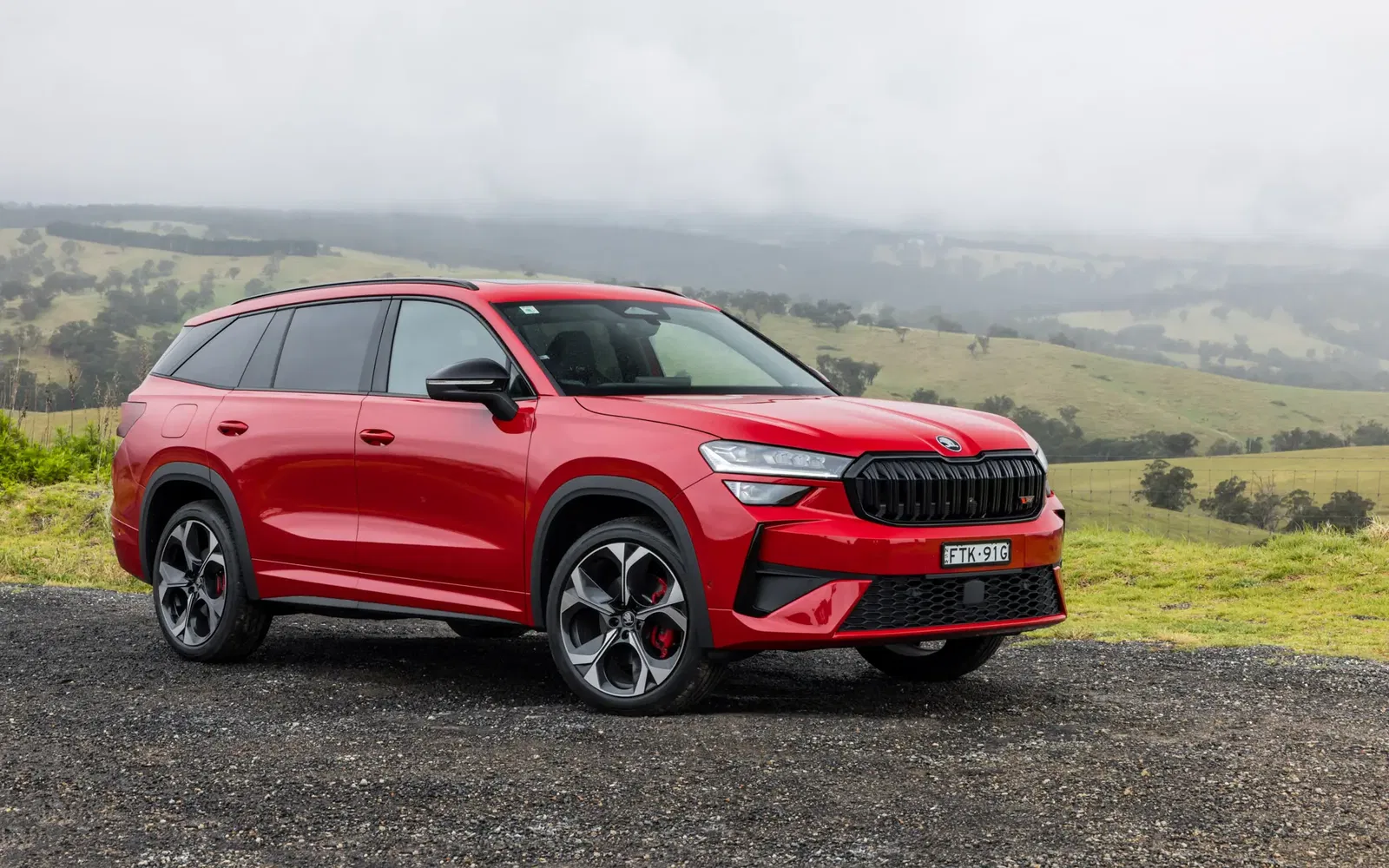
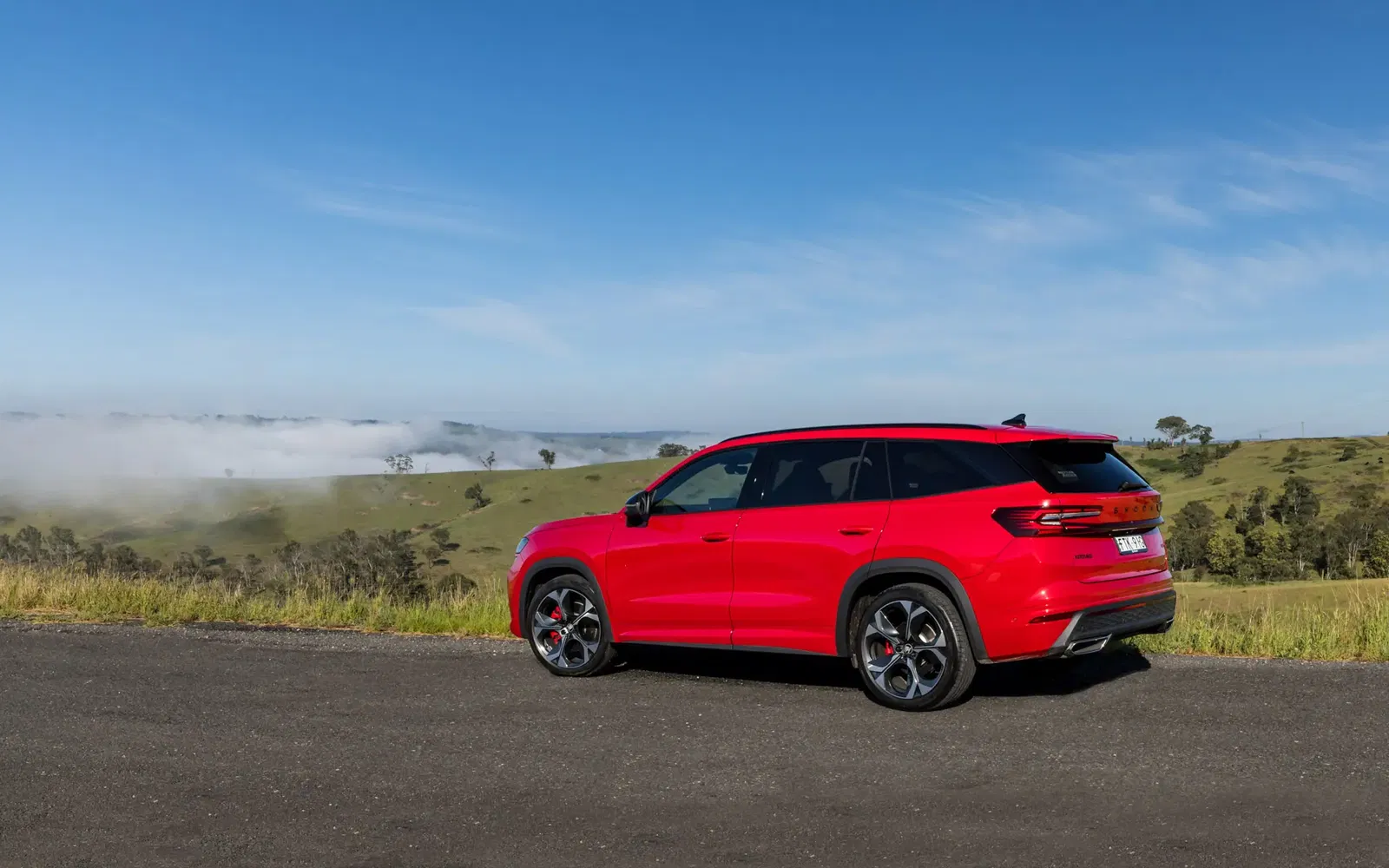
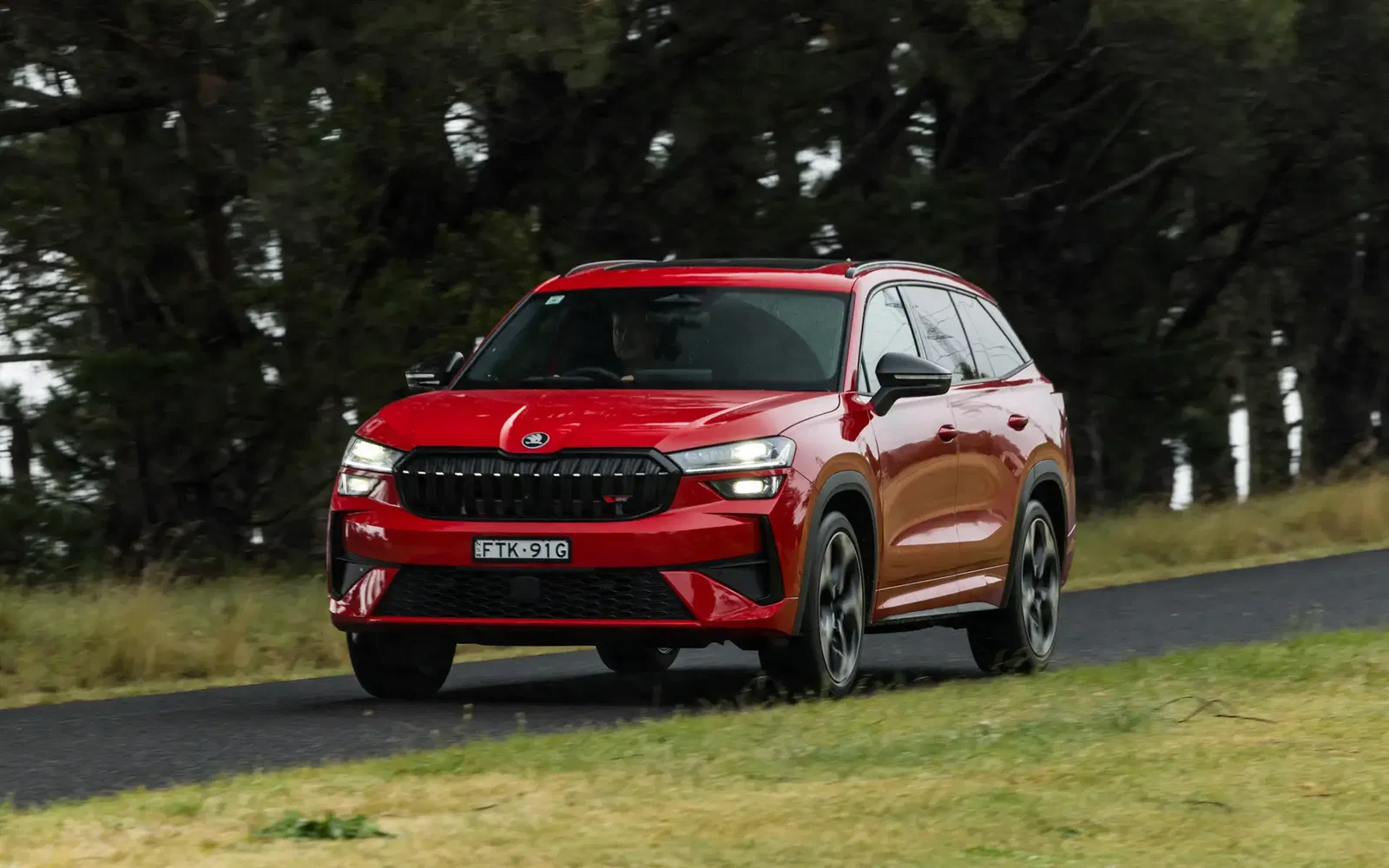
How much does the 2026 Skoda Kodiaq RS cost?
Prices for the 2026 Skoda Kodiaq RS start at $69,990 before on-road costs ($76,990 drive-away).
When it comes to before on-road pricing at least, the Kodiaq RS finds itself in fairly close proximity to the petrol Kia Sorento GT-Line ($66,290 before on-roads), mild-hybrid Mazda CX-80 G40e GT ($69,200 before on-roads), petrol Hyundai Santa Fe Calligraphy ($73,150 before on-roads), and its Volkswagen Tayron 195TSI R-Line 4Motion relative ($73,490 before on-road costs).

On paper at least, a performance SUV that seats seven that can be driven off the lot for under eighty grand is a pretty appealing prospect.
Furthermore, compared to the first generation, the additional standard equipment found on the new Skoda Kodiaq RS would’ve bumped the price of the original up by $8,000.
2026 Skoda Kodiaq RS Australian Price Before On-Road Costs
- $69,990
2026 Skoda Kodiaq RS Australian Drive-Away Price
- $76,990
Options
- Panoramic Sunroof: $1,900
- Velvet Red Metallic Paint: $770
For Those that Appreciate Subtlety
In both Select and Sportline guises, the second-generation Skoda Kodiaq was already a fairly handsome SUV to begin with, but the RS variant gives it a sporting edge.
Like the Sportline, the RS version features black exterior trim on the D-pillars, exterior mirrors, front grille surrounds, and rear diffuser, giving the Kodiaq a bolder, sportier look.
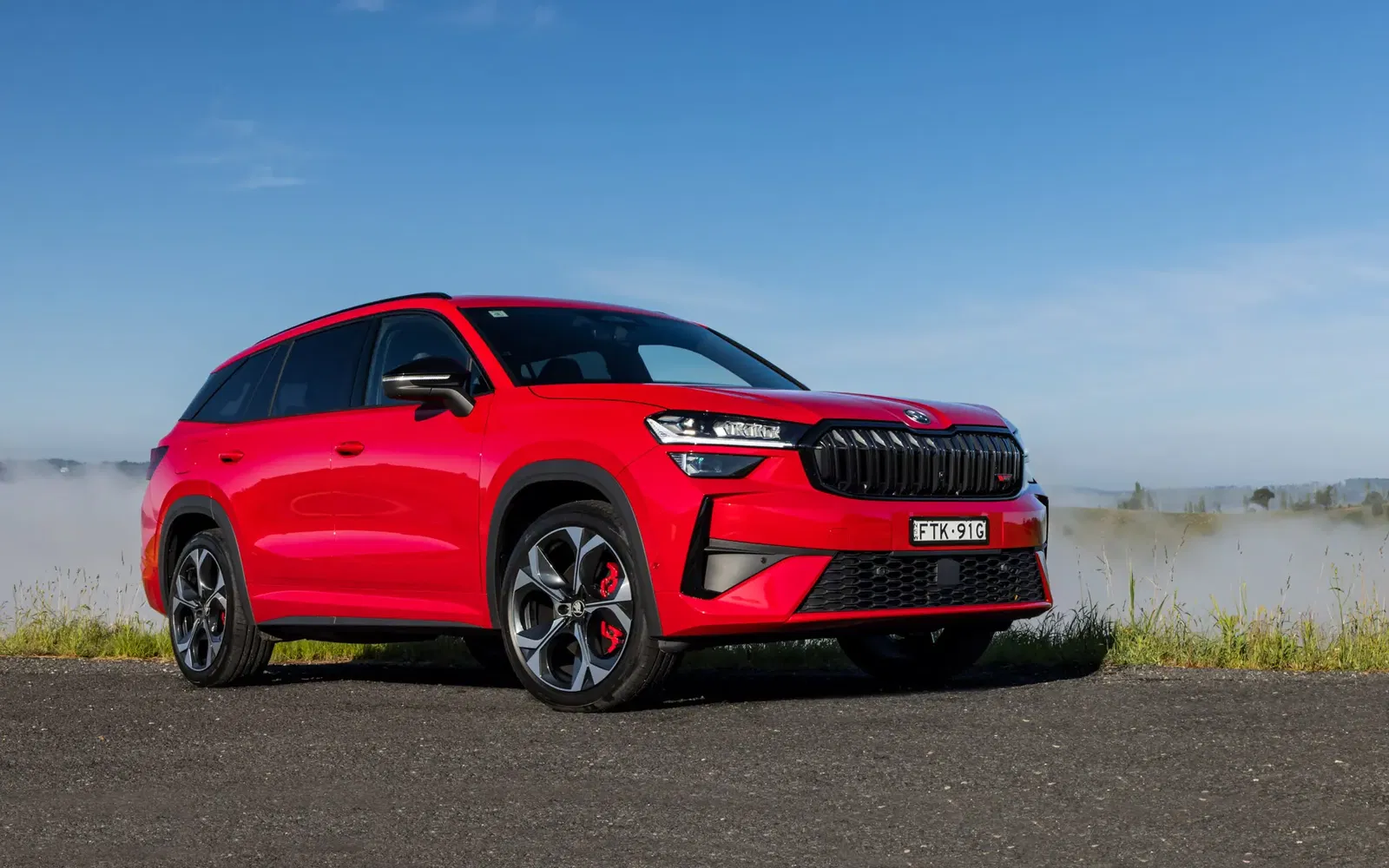
However, the RS takes this a step further, with an exclusive 20-inch wheel design, a more aggressive front bumper, dual stainless steel exhaust tips, as well as RS badging, differentiating it aesthetically from the Sportline.
If you’re looking for them, it becomes clear the Kodiaq RS is the performance variant, but it’s not overly shouty about it. It’s a level-headed, reserved approach to sports styling, something that seems to fit the Skoda brand well.

Some might find the styling too reserved, and the uninitiated will walk past it on the street without as much as a second glance. However, those in the know will recognise its pedigree. The Kodiaq RS will likely satisfy prospective buyers with a hankering for a little subtlety.


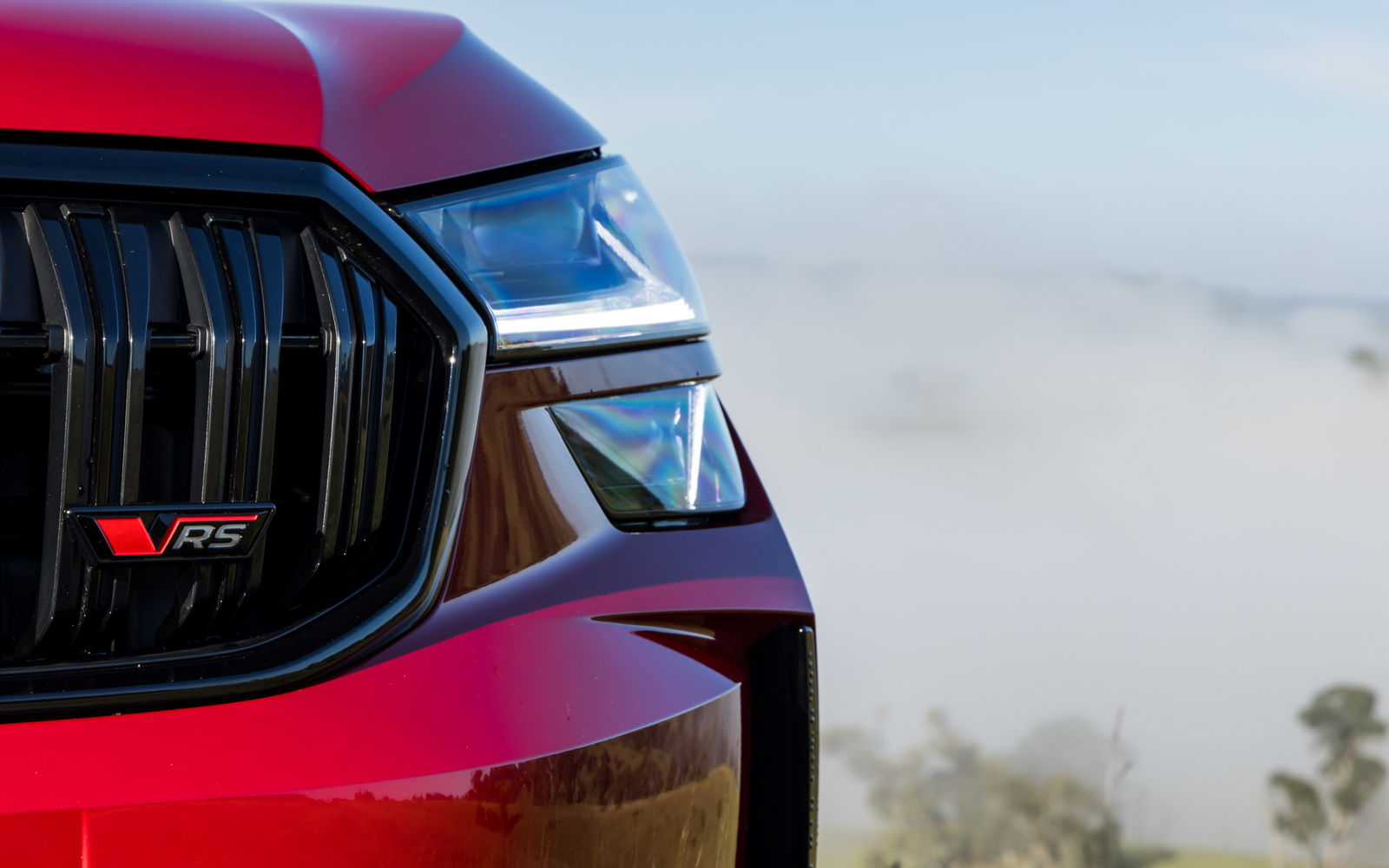
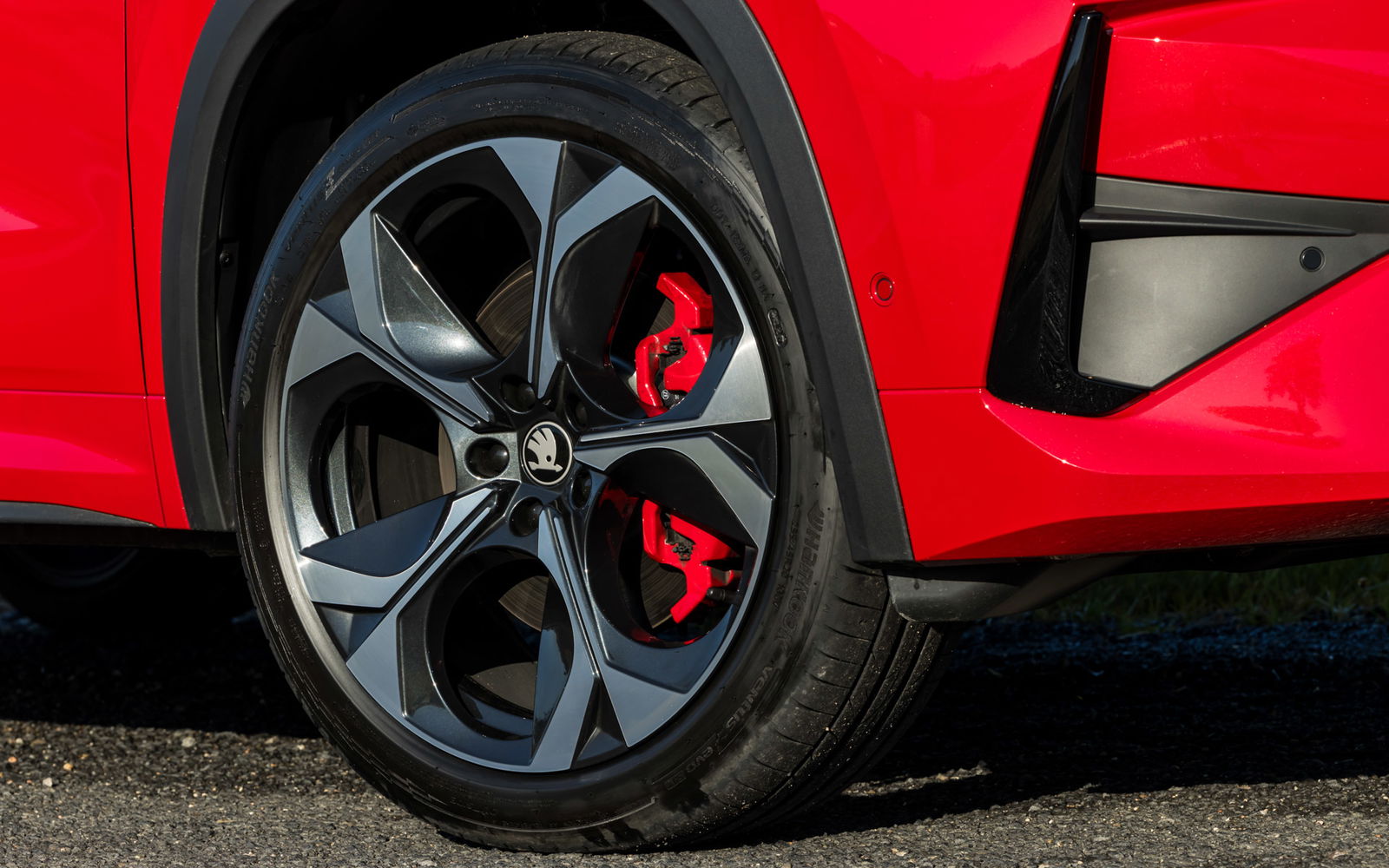
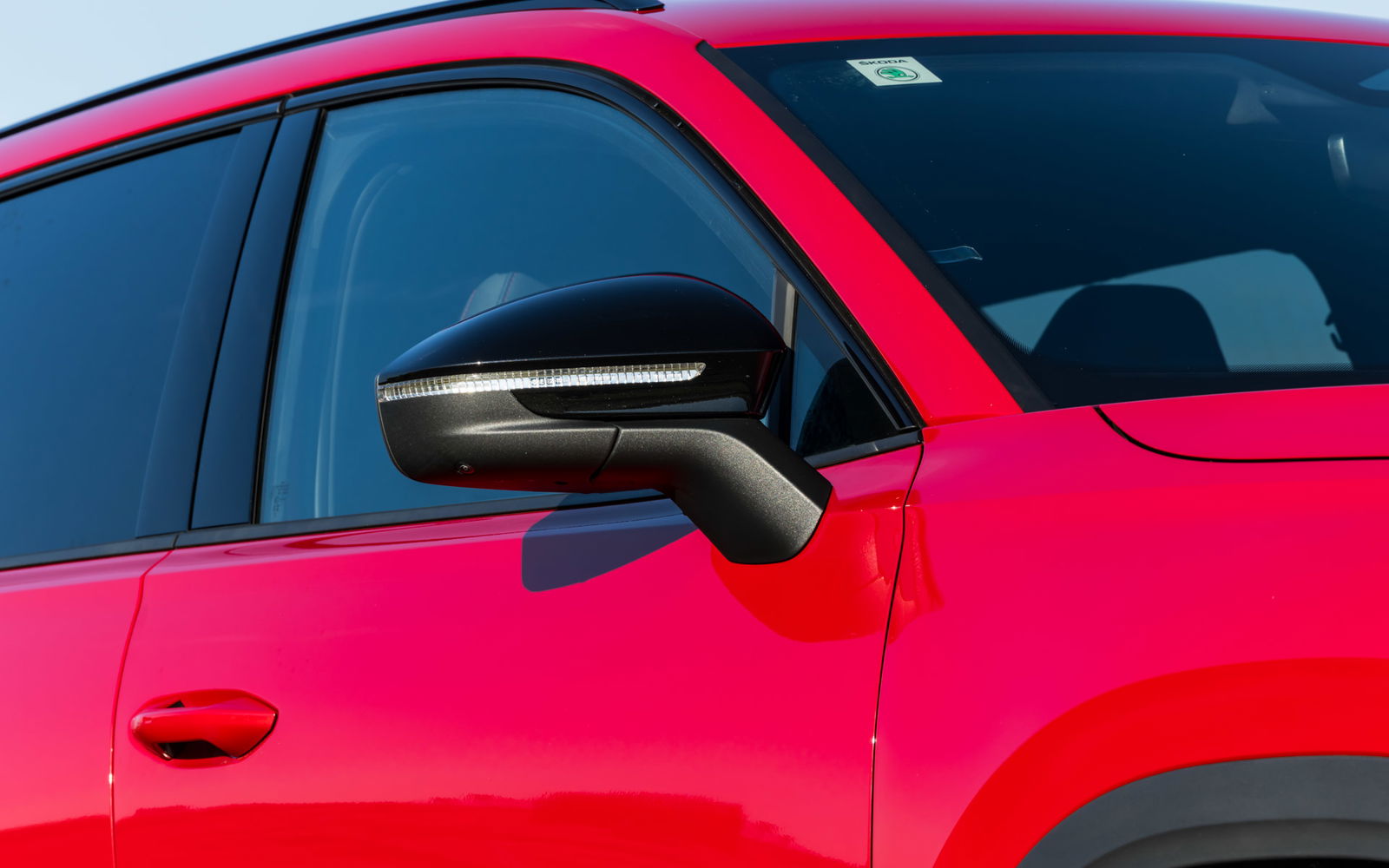
Dialled In
The interior of the 2026 Skoda Kodiaq RS boasts strong material choices, excellent usability, intuitive displays, and decent storage options.
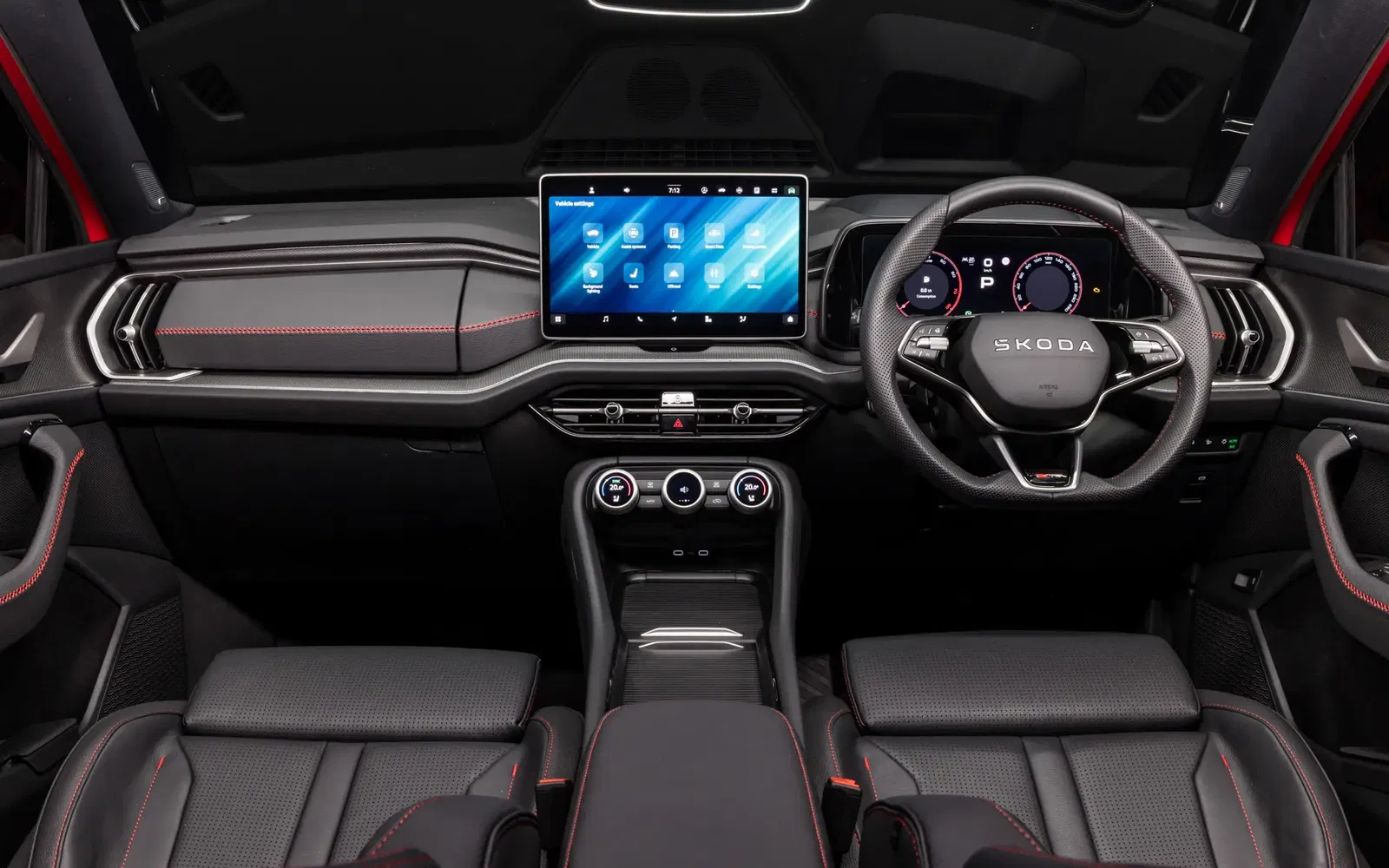
First of all, Skoda’s Smart Dials on the dashboard are a stand-out feature for me. The three dials – each integrating a digital display – can be used to adjust things like media volume, air conditioning temperature, fan speed, seat heating and ventilation, and to cycle between drive modes.
These dials are probably among the most intuitive features I’ve encountered in a modern car cockpit, allowing for quick adjustments to be made with ease.

The 13-inch touchscreen – compatible with Apple CarPlay and Android Auto – featured in the Kodiaq RS is crisp, slick and easy to navigate, as is the case for most modern Skoda products. The top and bottom navigation bars make getting around the system fairly easy, with quick access to media, navigation, ADAS, the Stop/Start system and other options.
This also rings true for the 10-inch digital instrument cluster, with aesthetically pleasing display options, which can easily be cycled through and interacted with via the steering wheel controls.
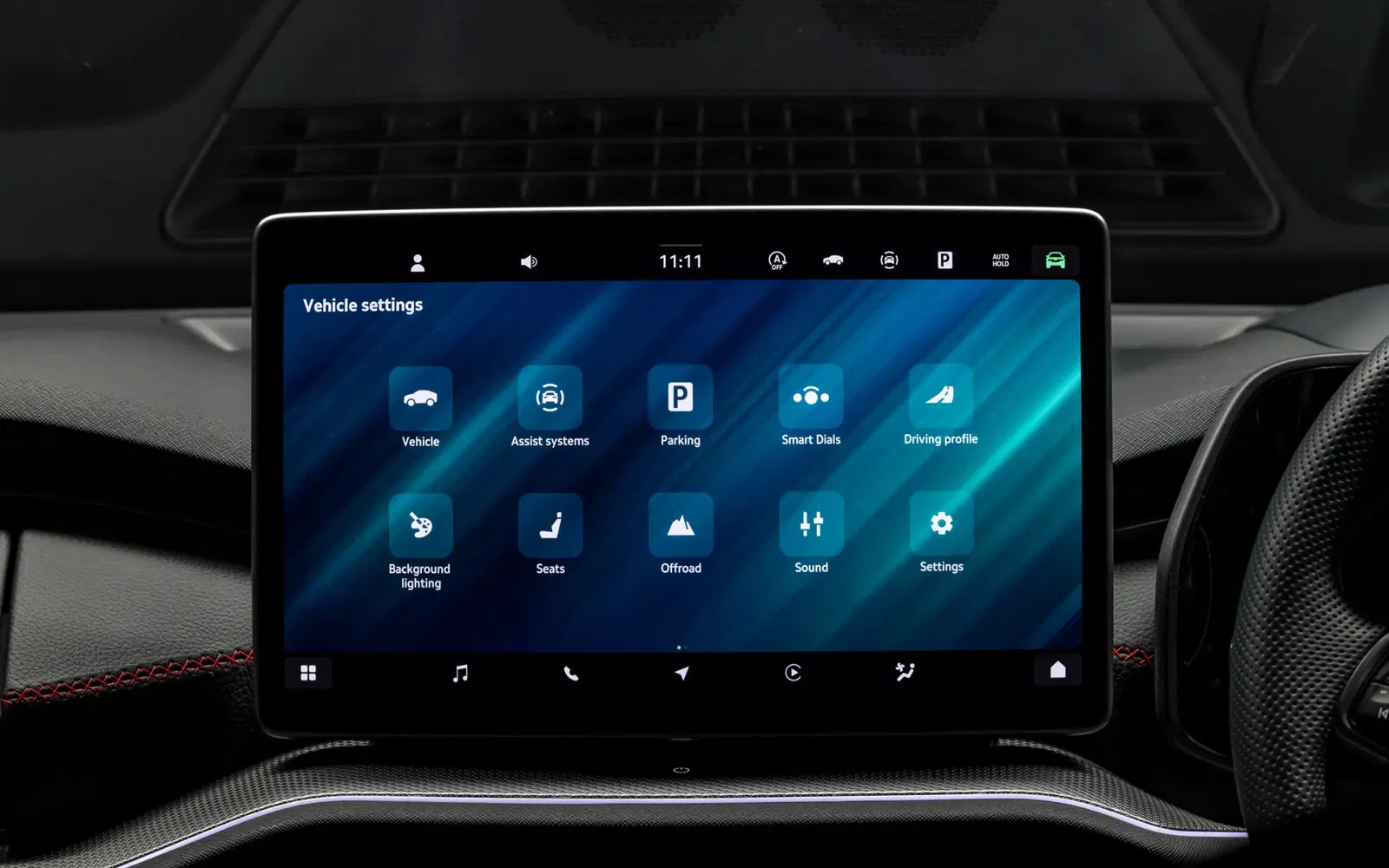
When it comes to storage, there are plenty in the front seat of the Kodiaq RS. While some of the storage options themselves are on the smaller side, because of how many there are, you don’t feel particularly shortchanged. Beneath the sliding covers on the centre console, you’ll find storage spaces for small items like keys and sunglasses.
There’s also a sliding plastic piece on top of the cupholders that can be moved backwards over an empty space in the dashboard to create a second set of holders. However, they are quite small, good for a 250ml plastic water bottle and nothing much larger than that.
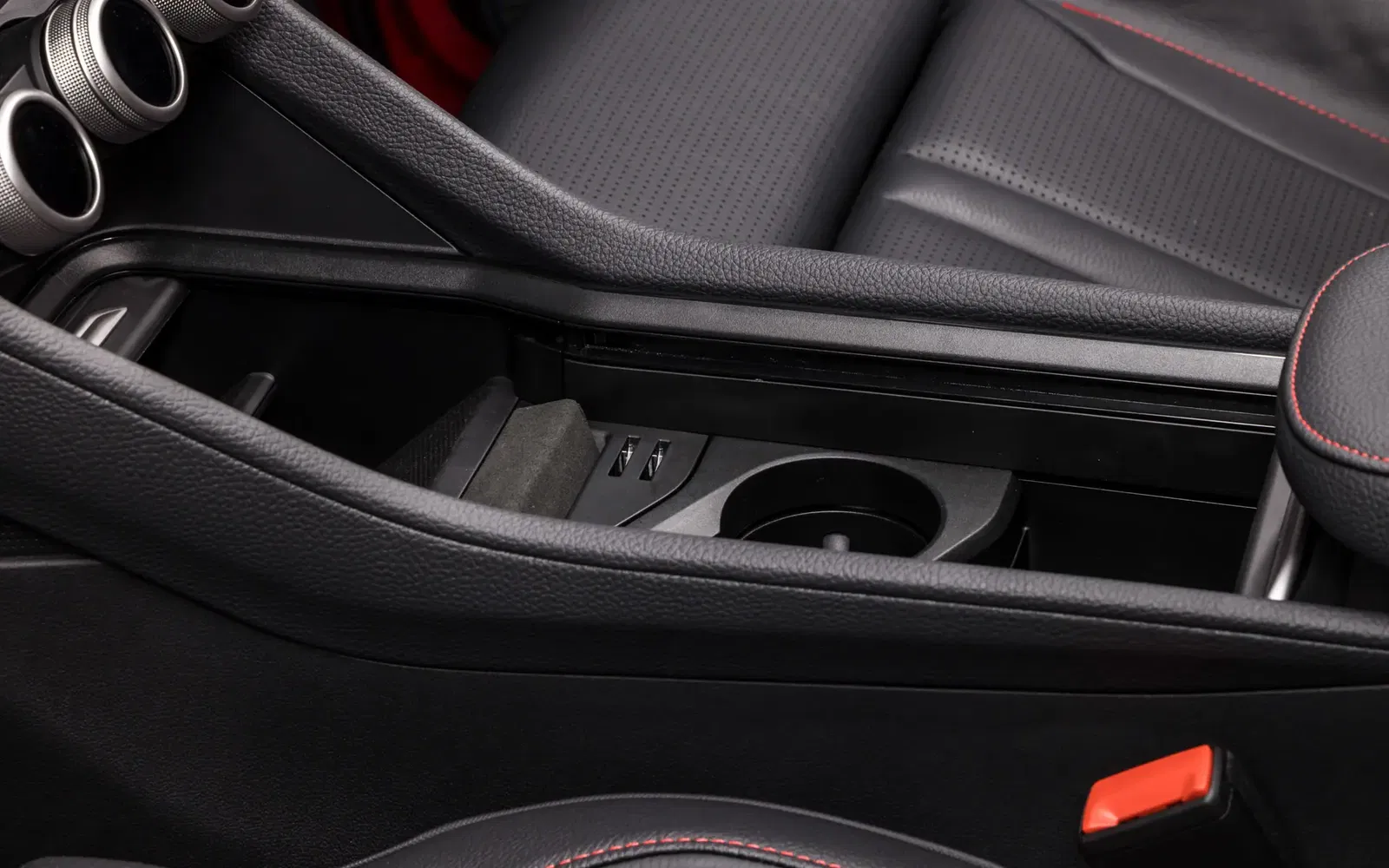
Further options include its two glove boxes, one beneath and one on top of the dashboard on the passenger’s side, as well as the centre console armrest, although as armrest storage goes, it’s on the smaller side.
These are joined by further practical Skoda touches such as an umbrella in the driver’s door, a rubbish bin mounted on the door cards, and a small infotainment display screen cleaner.
When it comes to charging options, front-row occupants have access to two ventilated wireless phone chargers contained beneath the sliding covers as well as three USB-C ports (two on the dashboard and one behind the rearview mirror).

As for material quality, most of the major touchpoints look and feel very pleasant, particularly the leather-appointed interior trim and the metallic-looking inlays that actually feel quite high quality for a plastic trim. However, the very tops of the doors feel a little cheap and scratchy.
Seat comfort is also excellent. The RS sports leather seats are plush and well-bolstered, and both front seats are power adjustable with lumbar and memory as well as heated and ventilated.
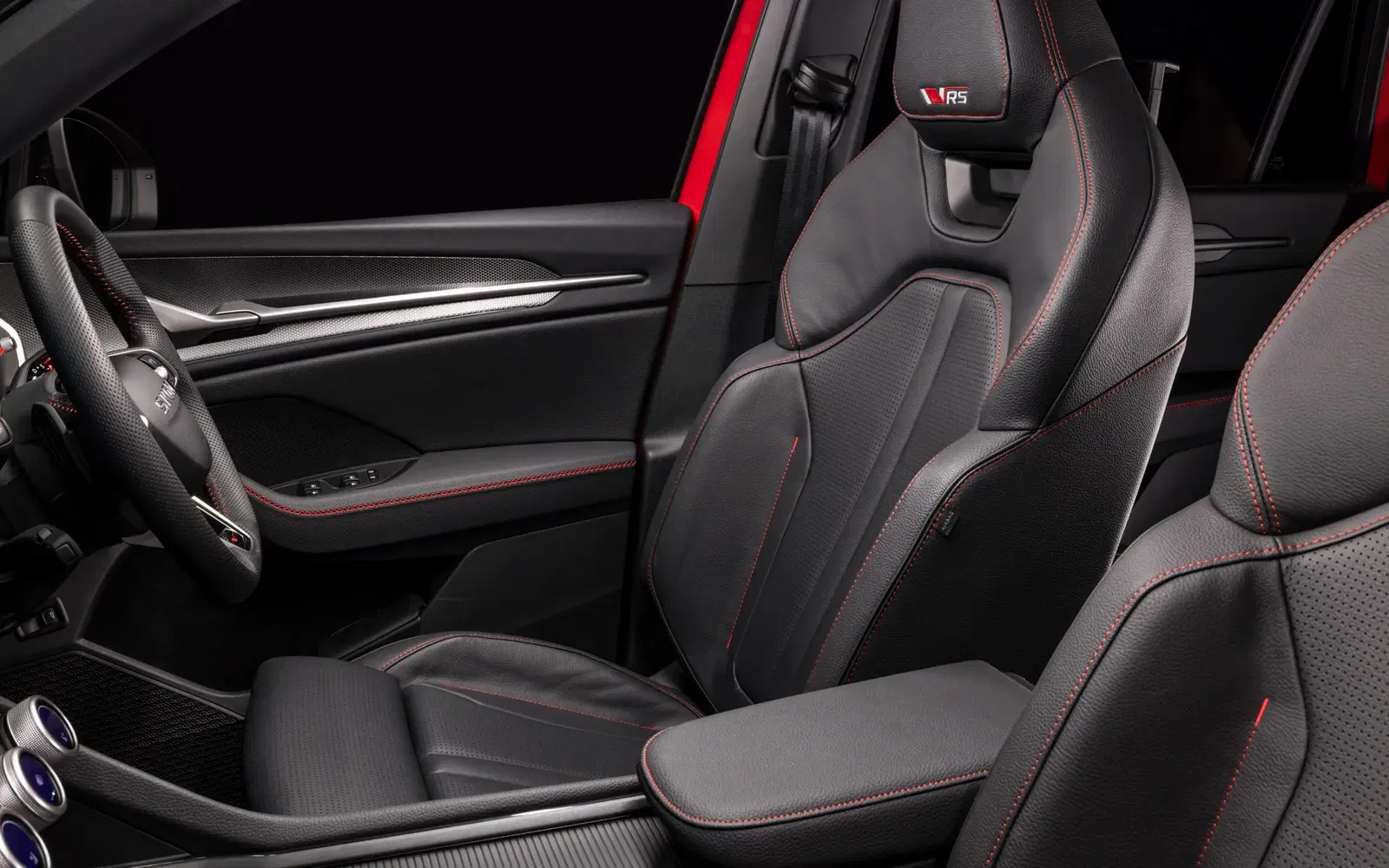
On the whole, the cockpit of the 2026 Skoda Kodiaq RS is a very premium feeling, user-friendly, fairly practical and well-equipped place to be.
A Strong Second Row as Always
In my experience at least, the second row of seats in current Skoda products tend to excel when it comes to space and creature comforts, and the 2026 Skoda Kodiaq RS is no exception.
Behind my own driving position (5’11”) I found that I had excellent knee room, with plenty of space for my feet underneath the seat in front. I could actually stretch my legs and feet quite far beneath the seat before eventually reaching a rise in the floor. I found headroom satisfactory, too, even with the optional sunroof equipped.
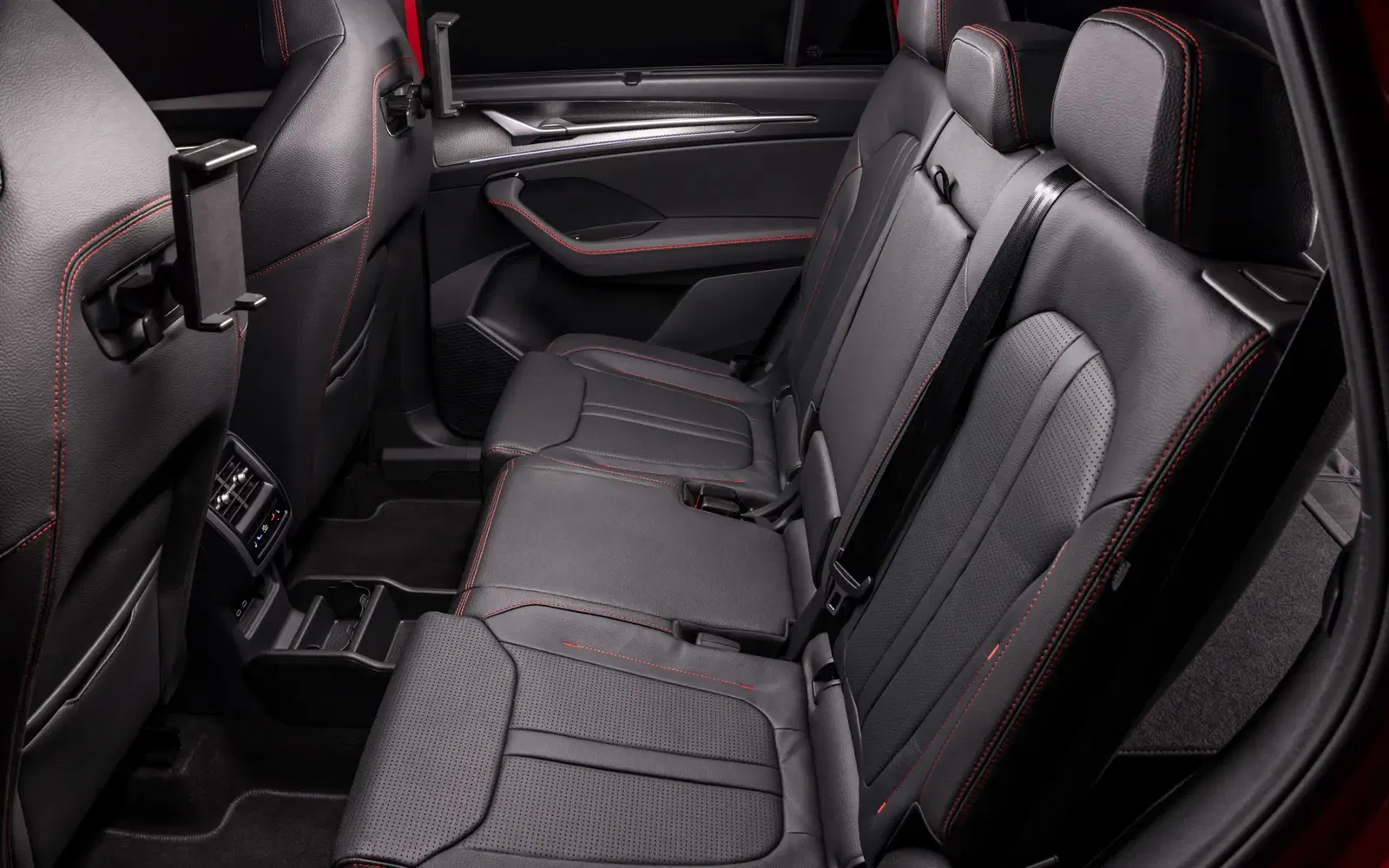
Middle seat passengers do have a transmission tunnel to contend with, but it’s not the largest I’ve encountered in an SUV, and it’ll still be comfortable at least for short journeys.
In terms of amenities, rear seat passengers have access to a centre folding armrest with cupholders, heated rear outboard seats, side window sunshades, seatback pockets, air conditioning controls, two USB-C ports, tablet holders on the back of the front seats, a 12V socket, and a removable storage compartment attached to the top of the transmission tunnel.
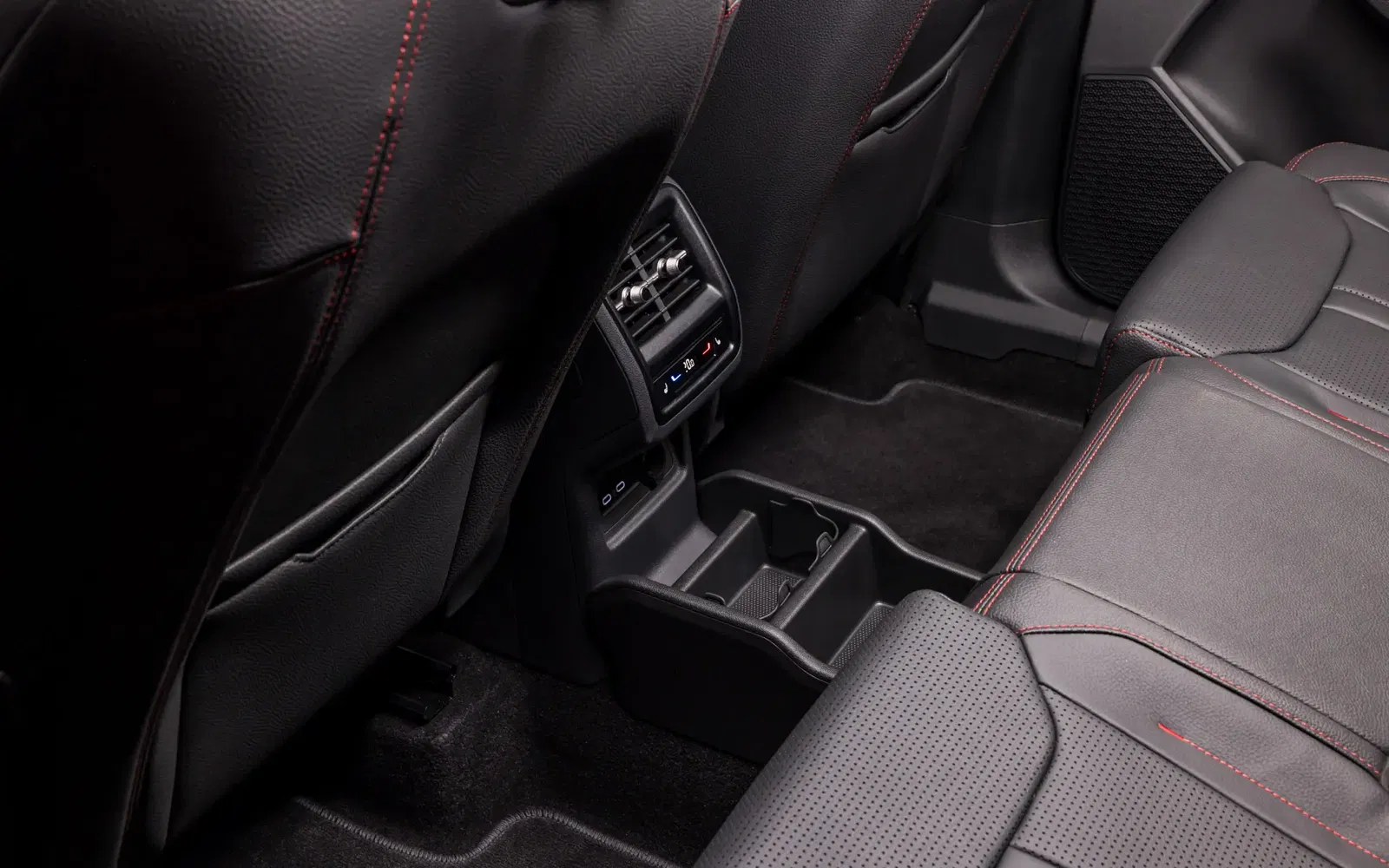
The immediate touchpoints – particularly the metallic inlays and leather seats and door trim – feel just as pleasant in the front row, save for the very tops of the door cards, which feel a bit plasticy and scratchy.
Overall, the second row of the 2026 Skoda Kodiaq RS offers substantial space and a strong list of amenities.
It’s a Bit Cramped
Accessing the third row in the 2026 Skoda Kodiaq RS is a fairly easy task, given that the second-row bench slides and folds forward. However, once you’re sitting in the rear-most seats, there isn’t much space for an adult.
There’s a little bit of space for adults with the second row slid forward a decent way – which takes space away from those passengers – there’s still not a lot of room. Slide the bench forward to its regular position, and the third row becomes virtually unusable for an adult. Realistically, this row is only usable for kids, and I suspect small ones at that. For adults, it’s short journeys at best.
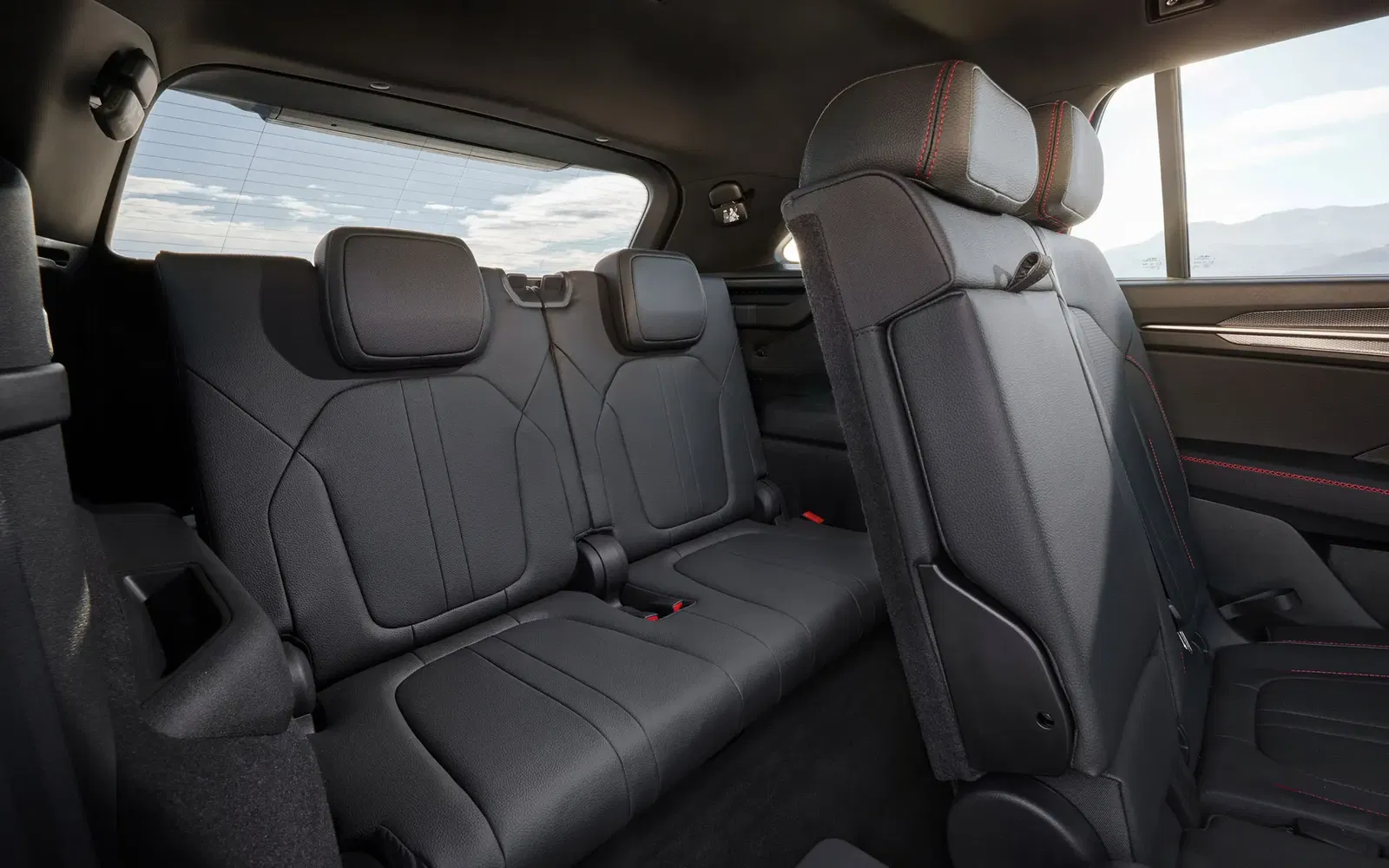
There isn’t much in the way of amenities to speak of in the final row, either. There’s a small area for placing small items off to the side, but that’s about it.
For transporting kids, the Skoda Kodiaq RS’s third row will just about do the job, but that’s as much comfort as these seats will provide.
Space and Features to Boot
The 2026 Skoda Kodiaq RS has 289 litres of boot space with the third row of seats up, rising to 794 litres with the rear-most seats folded, and 2,035 litres with the second row folded as well.
It has more boot space than the capacities quoted for the Mazda CX-80 and Kia Sorento, and while Hyundai doesn’t quote the Santa Fe’s capacity behind the third row, the Kodiaq bests its quoted capacity with the third seats down and both the second and third rows folded.
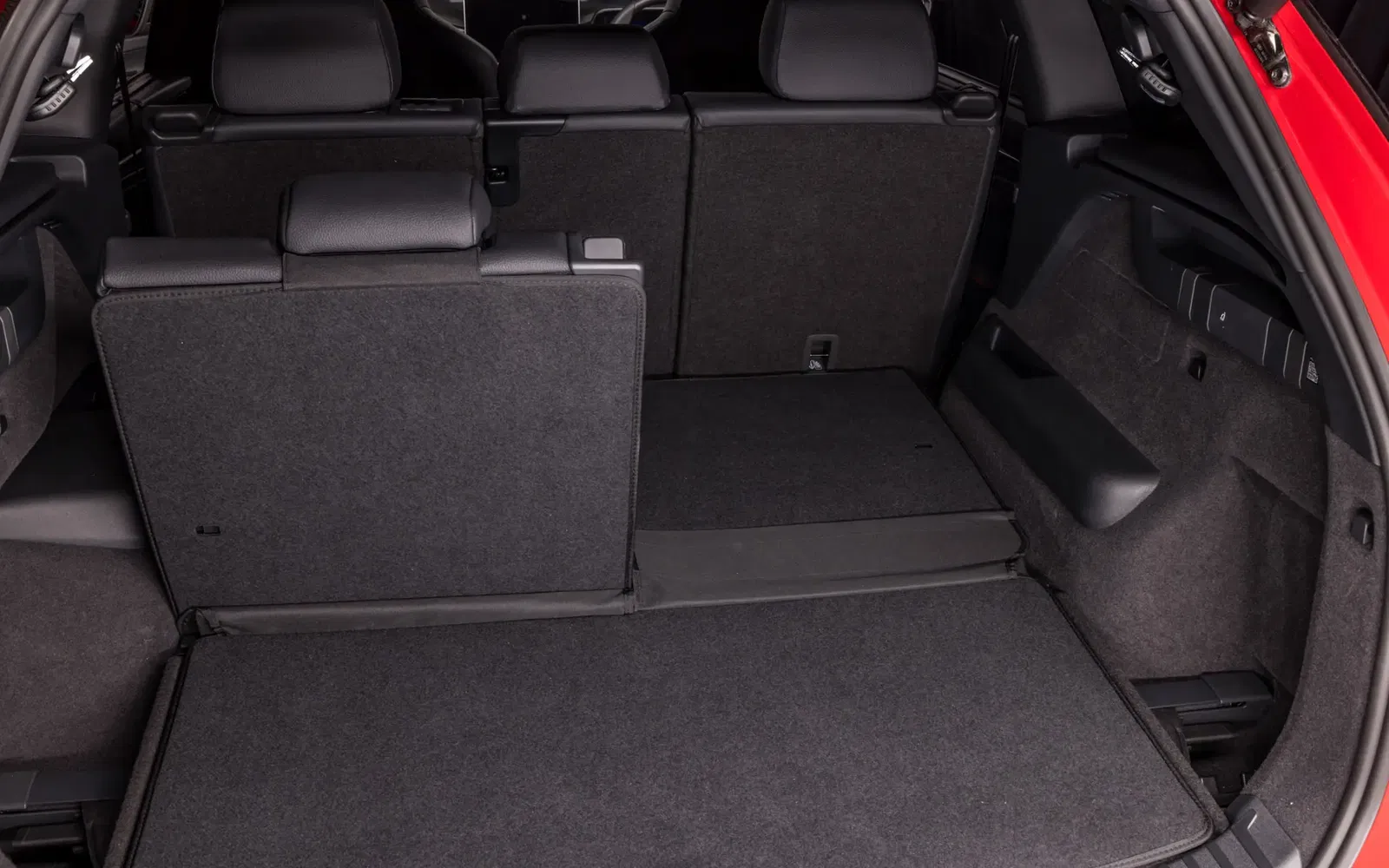
The Kodiaq’s Volkswagen Tayron relative has more space with all rows up and with the third row folded, but the former has more space with all three rows folded.
However, Skodas are known for their practicality beyond sheer capacity alone, and the Kodiaq RS is no exception. In the boot, you’ll find additional useful practicality features such as aluminium cargo elements to hold items in place, a variable boot floor, a luggage netting system and shopping bag hooks. There’s also a QR code explaining the boots' practical touches.
The Kodiaq RS also comes with a power tailgate with the motion-sensing ‘Virtual Pedal’ feature, as well as a space-saver spare wheel.
When it comes to practicality, the Kodiaq RS boasts extremely strong luggage space compared to its immediate rivals, while offering additional useful practical touches.
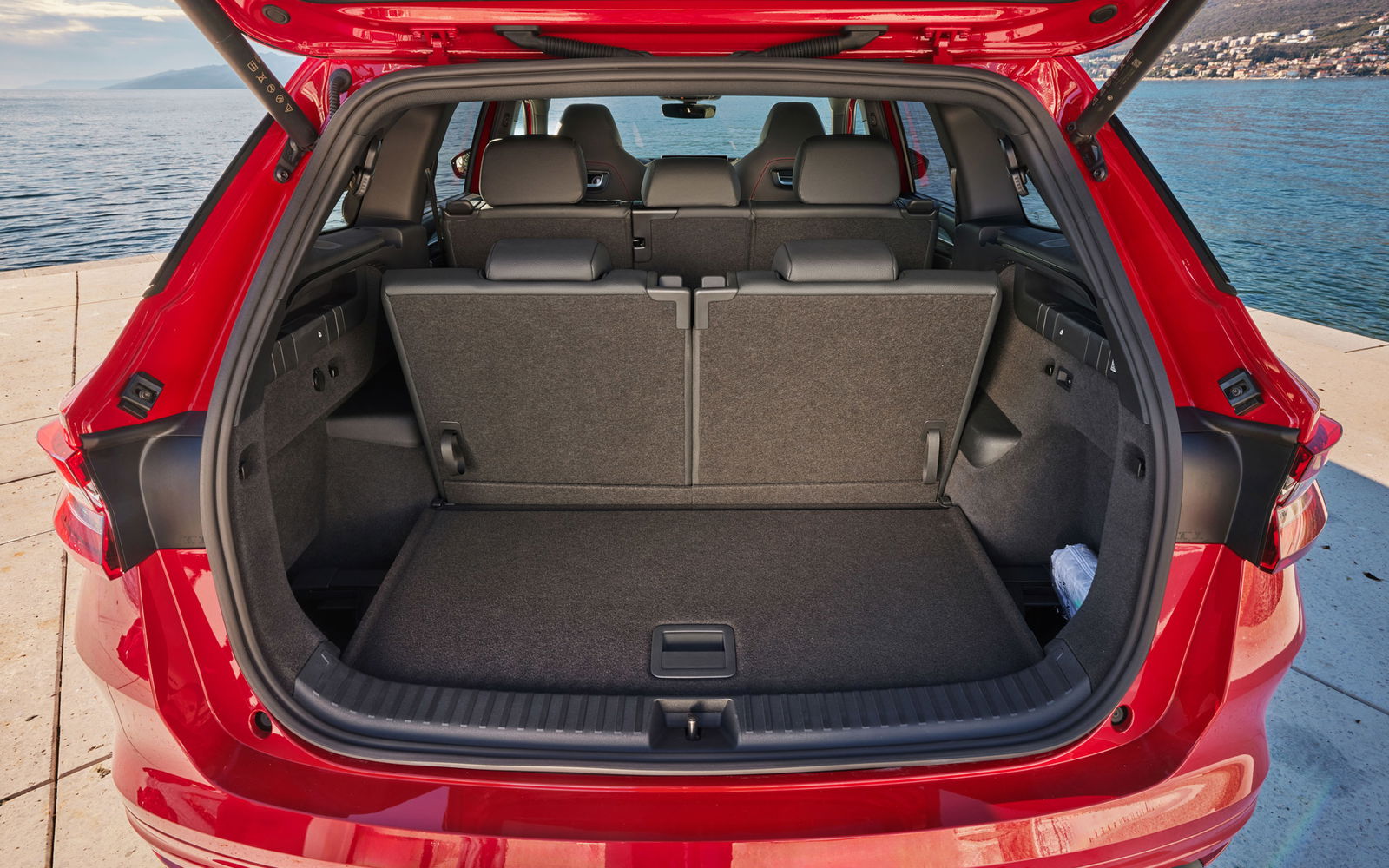
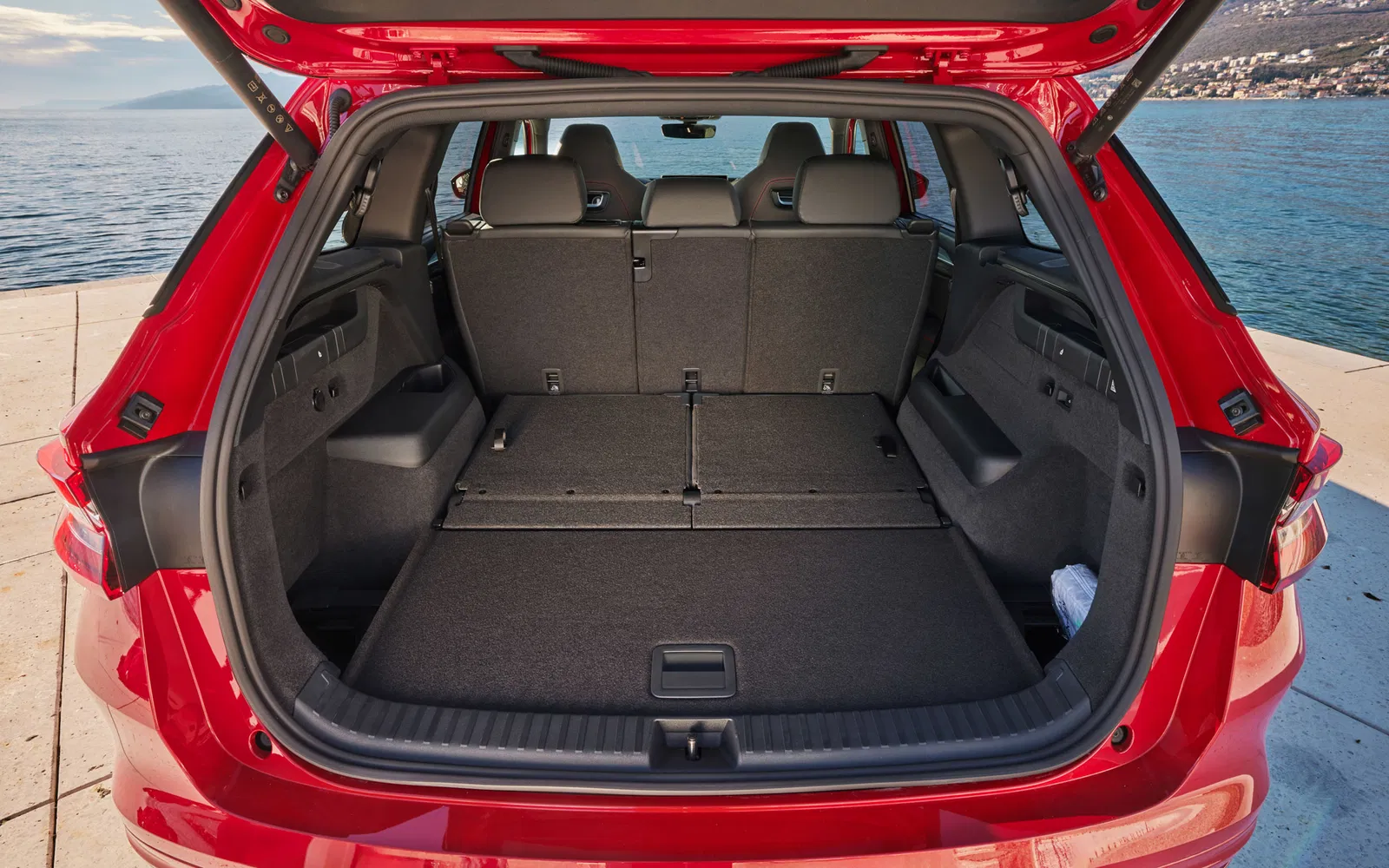
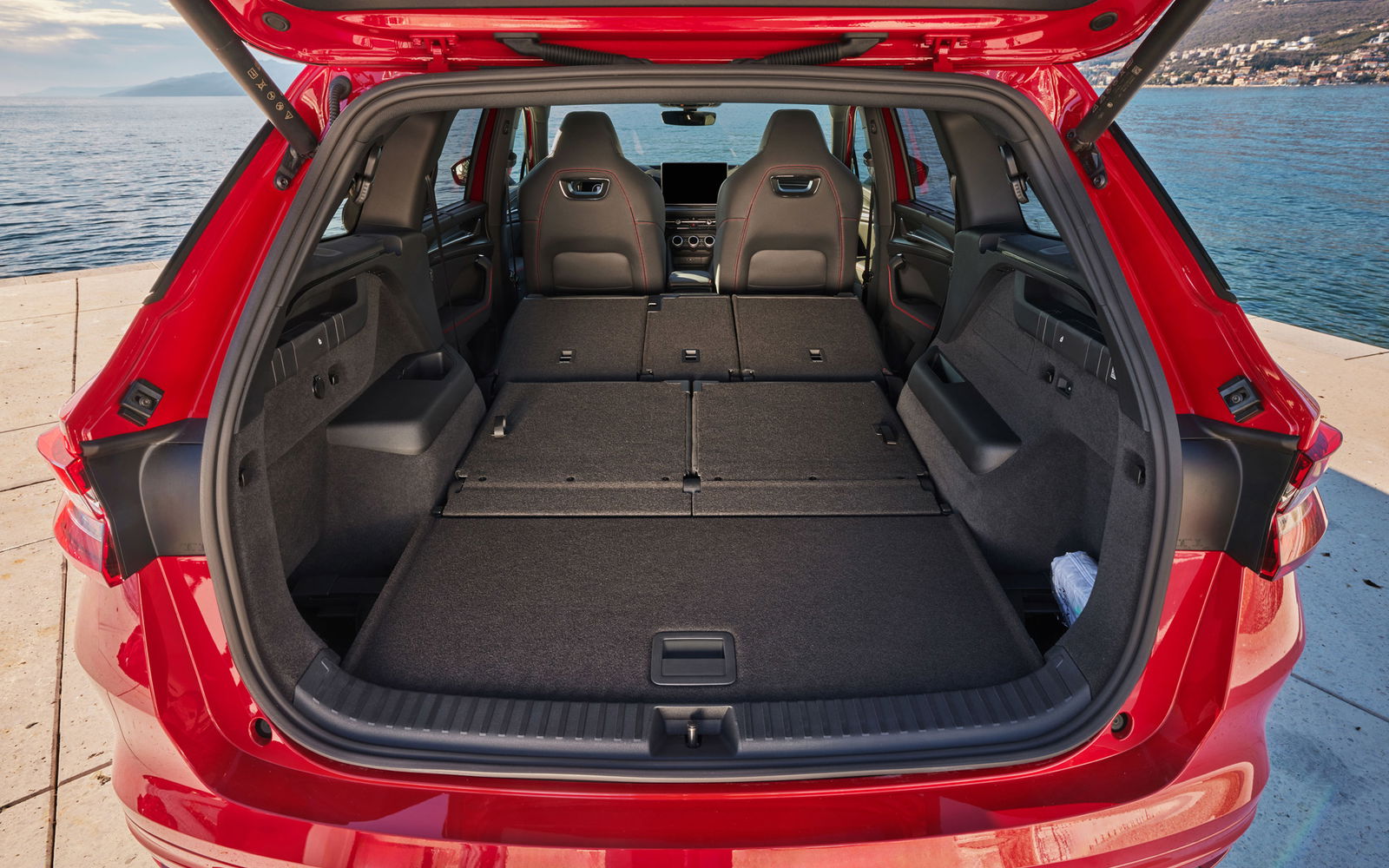
Output Figures Aren’t Everything
Power for the 2026 Skoda Kodiaq RS comes from the Volkswagen Group’s EA888 2.0-litre turbocharged four-cylinder engine, mated to a seven-speed dual-clutch transmission and all-wheel drive.
You’ll find the same four-pot unit with identical specs beneath the bonnet of its cousin, the Volkswagen Tayron 195TSI R-Line 4Motion, as well as the Skoda Superb Sportline.

In all three vehicles, it produces 195kW and 400Nm. For the Kodiaq RS, this marks a 15kW and 30Nm output increase over its predecessor.
Compared to its immediate rivals, it has more power and torque than similarly priced, two-wheel drive Kia Sorento GT-Line (200kW and 332Nm), but can’t quite match the firepower of the petrol Hyundai Santa Fe (206kW and 422Nm) or the mild-hybrid Mazda CX-80 G40e (209Nm and 450Nm).
However, the Kodiaq RS completes its 0-100km/h run in 6.3 seconds, quicker than the Mazda, Hyundai and Kia by seven tenths of a second, 1.6 seconds, and 2.2 seconds respectively. It only loses out to its Tayron relative by two tenths of a second.
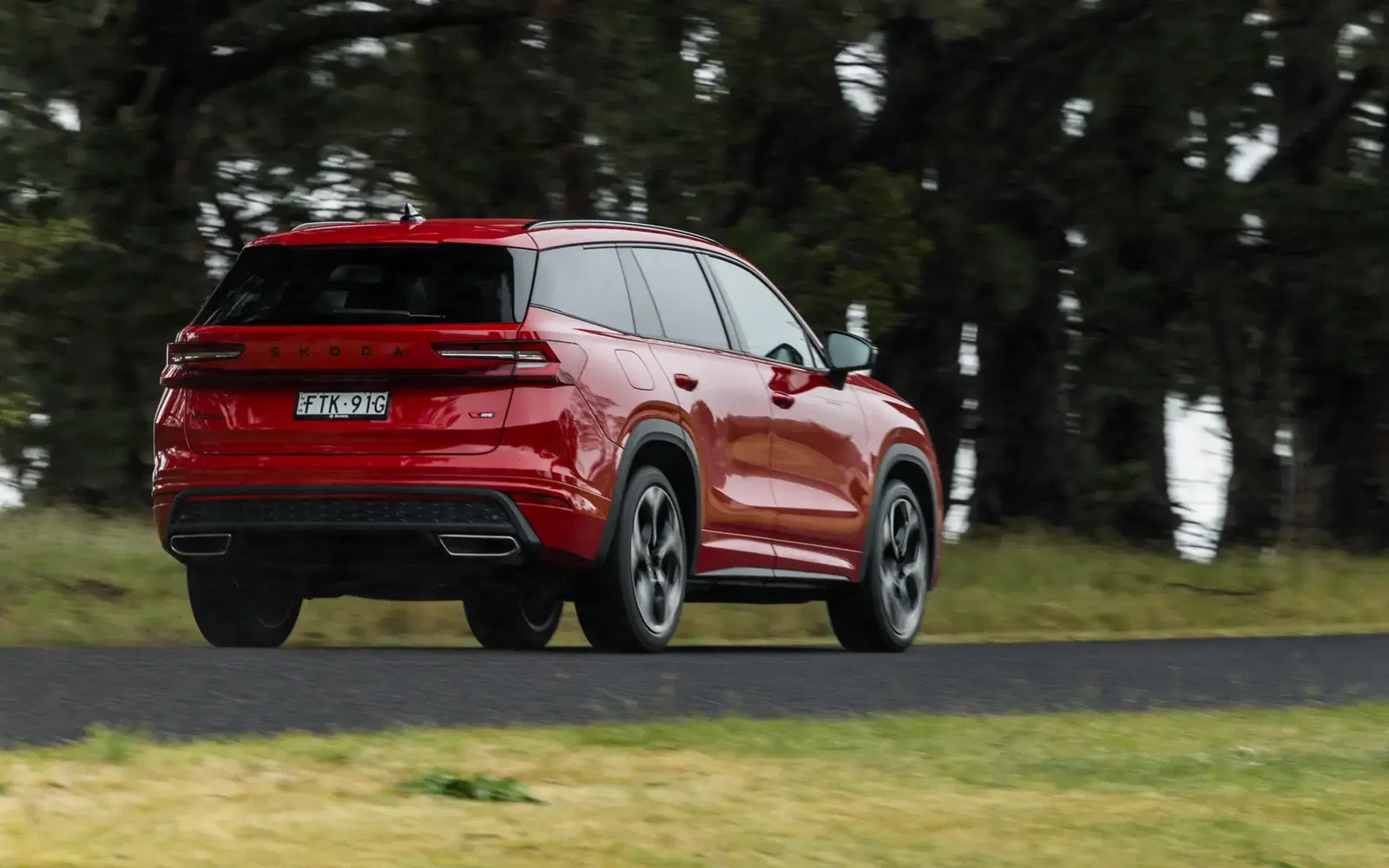
Claimed combined fuel economy is 8.1 litres per 100 kilometres, lower than the CX-80 G40e (8.4L/100km), Kia Sorento GT-Line (8.5L/100km), and the petrol Santa Fe (7.9L/100km). During my time putting the Kodiaq RS through its paces on urban streets, on the motorway, and on country backroads, the fuel readout generally posted figures within a litre either side of the Kodiaq’s claimed number.
The 2026 Skoda Kodiaq RS arrives with more power and torque than the car it replaces, and while it doesn’t quite match its immediate rivals on output figures alone, it wins out in acceleration.
Does it All
Drive modes are a fairly common feature on many new cars these days, and for the most part, the differences between modes are fairly minute and not particularly meaningful. This can’t be said for the 2026 Skoda Kodiaq RS. Each mode makes a meaningful difference.
There are seven driving profiles to choose from in the Kodiaq RS: Eco, Comfort, Normal Sport, Offroad, Snow and Individual. I spent my time with the Kodiaq RS alternating between the first four.
It’s quiet and easy-going in the Kodiaq RS when navigating urban areas or cruising on the motorway in Comfort mode. There’s little in the way of tyre, wind or road noise, and the Volkswagen group’s Dynamic Chassis Control Plus adaptive suspension system is evidently set to soft, offering excellent ride comfort without feeling bouncy or wallowy.
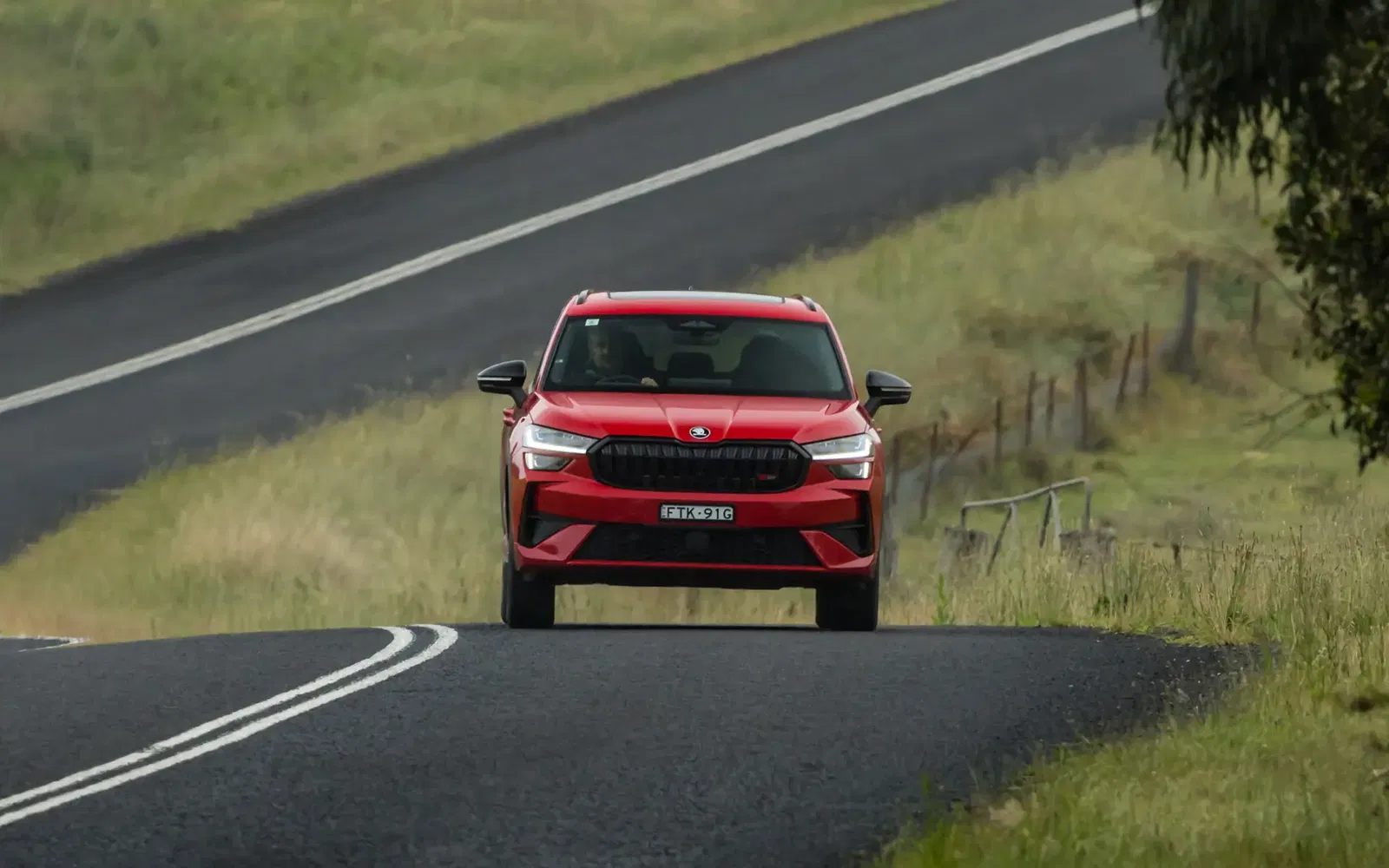
Eco feels relatively similar to comfort, but the powertrain doesn’t feel so immediately responsive.
Switch over to normal, and more engine noise and sound from the outside world is pumped into the cabin via the speaker system, and the suspension feels a little firmer. Sport mode takes this another step further, and the steering also becomes noticeably heavier. However, even with the suspension firmed up, the Kodiaq RS rides brilliantly in all modes.
When the roads got twisty, I mainly used the latter mode during my time with the Kodiaq RS. Given the very rainy conditions on the day I drove it, I don’t think I ever saw it at its true performance potential, but it was still easy to hustle.

Through the corners, the Kodiaq RS feels confident and easy to place. Its progressive steering feels appropriately weighted, direct, and it offers decent feedback.
True, there’s a lot of weight to shift when cornering, and you’re aware of the Kodiaq RS’s mass moving to one side. But it communicates its behaviour so well that it’s still confidence-inspiring, even in the wet.
As for the powertrain, the engine and transmission pairing work responsively together, and it delivers its considerable performance very quickly. You’ll certainly find yourself moving at a considerable rate of knots shortly after planting your foot.

In Comfort mode, you don’t hear much of it, but in Normal and Sport, you get to hear more of the engine note through the car’s speaker system. While it may a somewhat artificial sound pumped through the speakers, the four-pot sounds almost V8-adjacent, and it adds to the theatrics.
Each mode makes genuinely discernible differences in the on-road driving characteristics of the Skoda Kodiaq RS. Comfort is probably the best mode for daily commuting and driving activities, but if you want to have a play, Sport mode is there for you too. If none of these modes suit you, then you can tune it to your liking through the Individual setting.
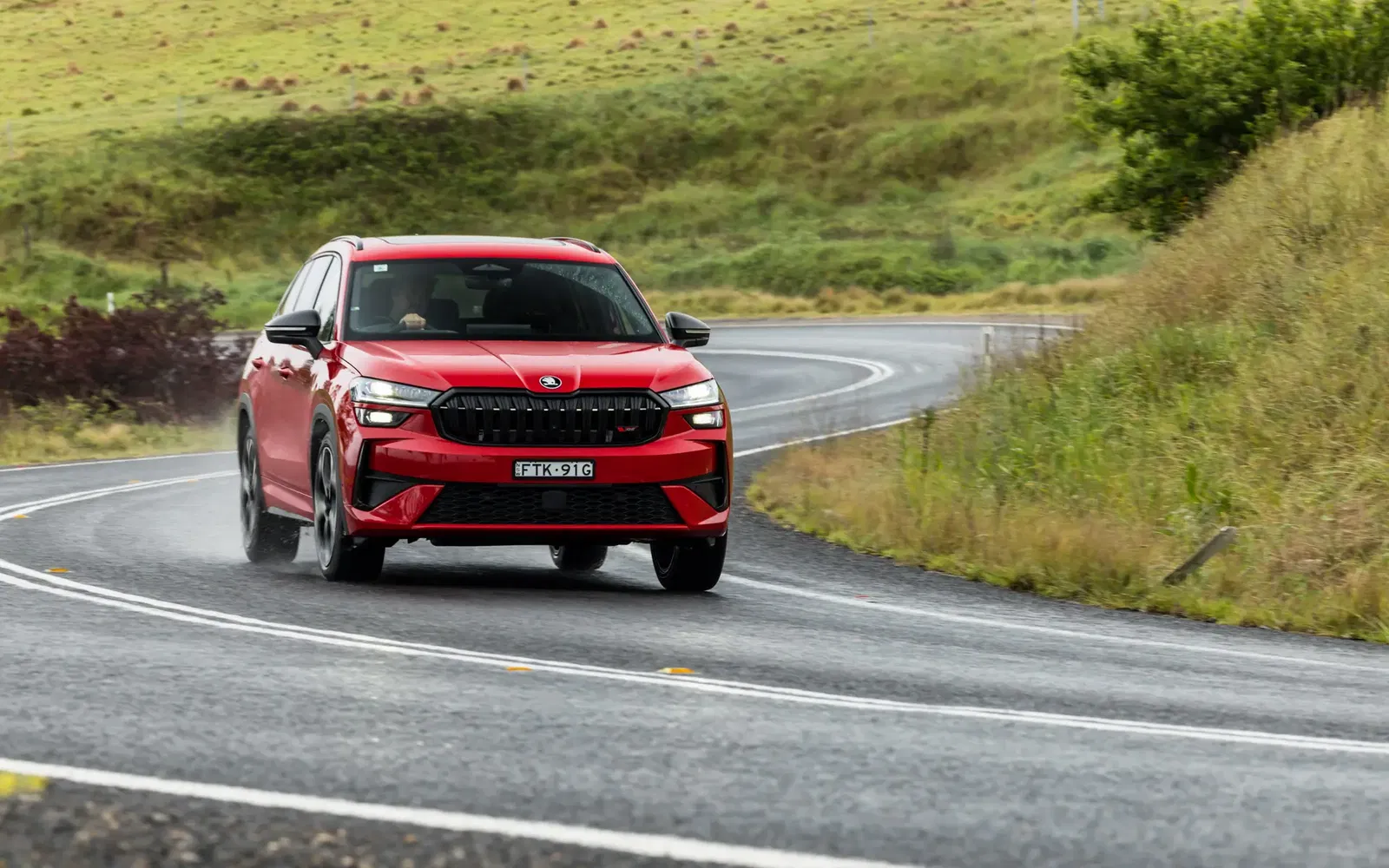
When it comes to ADAS safety systems, they're brilliantly calibrated for the most part. Any intervention was largely light and non-intrusive, particularly on the part of Lane Assist, which gently brought me back into line when needed. Turn on Travel Assist – which incorporates the Adaptive Cruise Control, Adaptive Lane Assist, Traffic Jam Assist, and Emergency Assist systems while displaying traffic sign information to the driver – and motorway driving is made fairly easy.
Ultimately, the 2026 Skoda Kodiaq RS is essentially able to take on one of multiple personalities as the want or need arises, making it a very versatile vehicle out on the road. It’s quiet, comfortable and sensible when you want it to be, while also offering an enjoyable, sporty drive when the occasion comes.
Five Stars and Well-Sorted Kit
All variants of the second-generation Skoda Kodiaqhave been awarded a five-star ANCAP safety rating, scoring 89 per cent in Adult Occupant Protection, 87 per cent in Child Occupant Protection, 82 per cent in Vulnerable Road User Protection and 81 per cent in Safety Assist.

For the most part, the safety systems feel well-calibrated and non-intrusive, but effective when they need to be. For instance, Lane Assist’s interventions are gentle, but bring you back into line as needed.
If the systems aren’t to your liking, they can be customised through the infotainment system, easily accessible via the infotainment system.
Safety features equipped on the 2026 Skoda Kodiaq RS include:
- Predictive Adaptive Cruise Control (Stop & Go)
- Travel Assist
- Lane Assist w/ Adaptive Lane Guidance
- Front Assist (City/Pedestrian/Cyclist)
- Side Assist w/ Front & Rear Traffic Alert
- Emergency Steering Assist
- Exit Warning System
- Turn Assist
- Advanced Driver Fatigue Detection
- Traffic Sign Recognition
- Predictive Speed Limiter
- Surround Camera View
- Intelligent Park Assist
- Front & rear parking sensors
- Traffic Jam Assist
- Crew Protect Assist
- 9 airbags (front, centre, thorax & curtain for front and rear)
- Multi-Collision Brake
- Tyre Pressure Monitoring System
Expensive Servicing Compared to Some Rivals
The 2026 Skoda Kodiaq RS comes with a seven-year, unlimited-kilometre warranty, matching rivals like the Kia Sorento and Hyundai Santa Fe, and offering two years more than the Mazda CX-80.
It’s also available with a five-year, 75,000km prepaid service pack, priced at $3,000, with a two-year top-up available for an additional $700. Servicing intervals come once every come every one year or 15,000km.
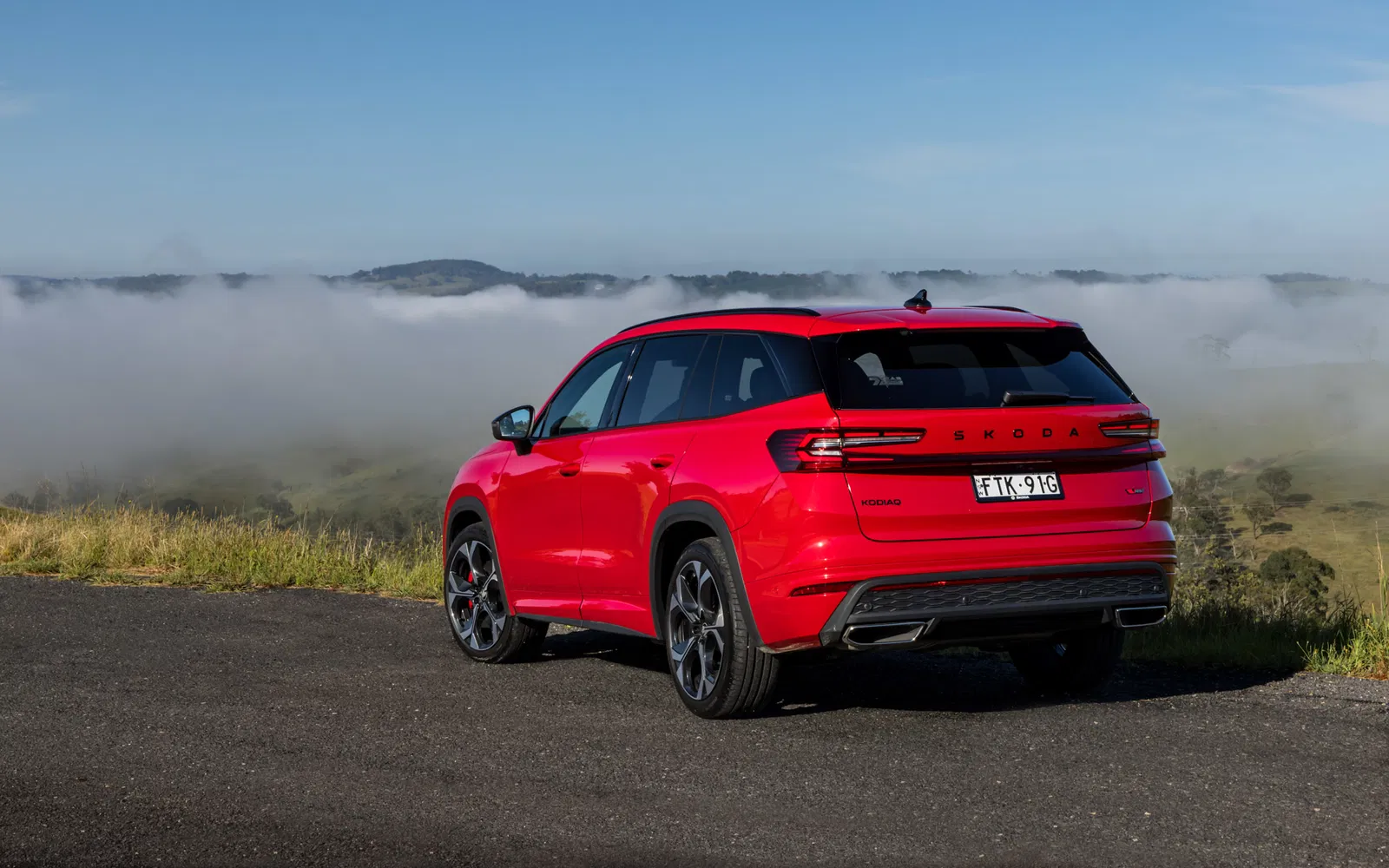
Compared to other offerings in the segment, the Kodiaq RS certainly isn’t the cheapest to service. The Hyundai Santa Fe and Kia Sorento each cost far less. But it’s still cheaper than its Volkswagen Tayron 195TSI R-Line 4Motion cousin and the Mazda CX-80 G40e, which are $550 and $469 more expensive to service over the first five years, respectively.
With each scheduled service, Kodiaq RS owners will also receive 12 months of roadside assistance.
Like its non-RS stablemates, the Kodiaq RS requires a minimum of 95 RON fuel, making fuel slightly more expensive compared to rivals like the petrol Hyundai Santa Fe and Kia Sorento and the mild-hybrid Mazda CX-80, as these vehicles are all compatible with 91.
What do you get with the 2026 Skoda Kodiaq RS?
Standard equipment on the 2026 Skoda Kodiaq RS includes:
- 10-inch digital instrument cluster
- 13-inch infotainment touchscreen
- Heads-up display
- 13-speaker sound system
- DAB+ digital radio
- Wired & wireless Apple CarPlay and Android Auto
- Ventilated wireless phone chargers (x2)
- Voice control
- Dynamic Chassis Control Plus (DCC+)
- Progressive Steering
- Driving Profile Selection
- 20-inch alloy wheels (black polished)
- RS sport black perforated leather-appointed upholstery
- 3-spoke flat-bottom perforated leather steering wheel w. paddles, red stitching & RS logo
- Heated steering wheel – Upgraded
- Power-adjustable front seats w/ cushion depth, lumbar, memory & easy-entry functions
- Sport comfort front seats w/ integrated headrests
- Aluminium finish pedals
- RS glossy black exterior elements
- Black roof rails
- Black headliner & D-pillar trim
- Tinted rear & rear side windows
- Metallic paint
- Matrix LED headlights w/ Adaptive Front-lighting System
- LED fog lights w/ cornering & all-weather function
- LED rear taillights w/ dynamic indicators
- LED rear fog lights
- LED daytime running lights
- “Coming/Leaving home” & dusk light assist
- Skoda logo illumination in mirrors
- LED ambient lighting w/ customizable colours
- Tri-zone climate control
- Keyless Advanced entry with approach/walkaway unlocking
- Smart Dials
- Auto-dimming rear-view mirror
- Heated front and rear seats
- Ventilated front seats
- Power tailgate w/ Virtual Pedal
- USB-C sockets (x2 front, x2 rear console, x1 rear-view mirror)
- Double-sided boot mat
- Electronic child safety locks (rear doors)
- Space-saving spare wheel
- Rear centre storage compartment
- Aluminium cargo elements
- Dry display cleaner
- Door pocket rubbish bins
- Driver’s door umbrella
Final Thoughts
The 2026 Skoda Kodiaq RS offers a comfortable yet dynamic driving experience, a well-designed and luxurious interior, excellent safety, great practicality, and represents strong value for money.
Most of its issues are rather insignificant in the grand scheme of things. For instance, the cupholders and centre console armrest storage are arguably too small in the front row, and some scratchy plastics detract slightly from the otherwise excellent interior, for instance.

The lack of space in the third row is a bit of a weak point. For owners with young kids, this won’t be a problem, but if you have to move seven adults, there are probably better options. It’s also not the cheapest of its rivals to service.
However, as a holistic package, the 2026 Skoda Kodiaq RS brilliantly combines sensible usability and comfort with performance prowess. As fast large SUVs go, the new RS certainly has a lot to offer.
Saucey rating breakdown
Saucey rating breakdown
FAQ
Sign up to our newsletter
Be the first to know when we drop new car reviews.
.avif)



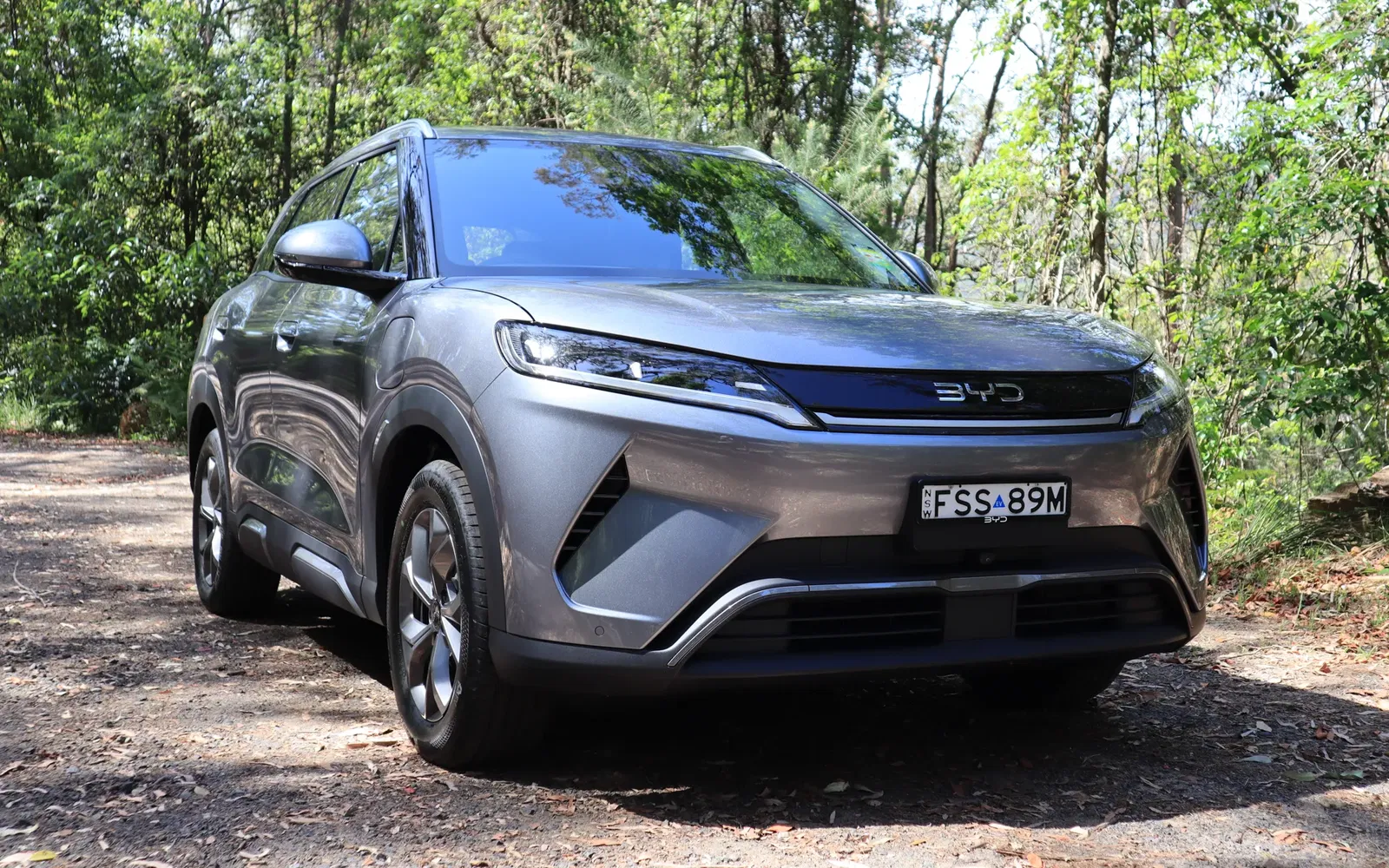

%20Calligraphy%20-%2003.webp)